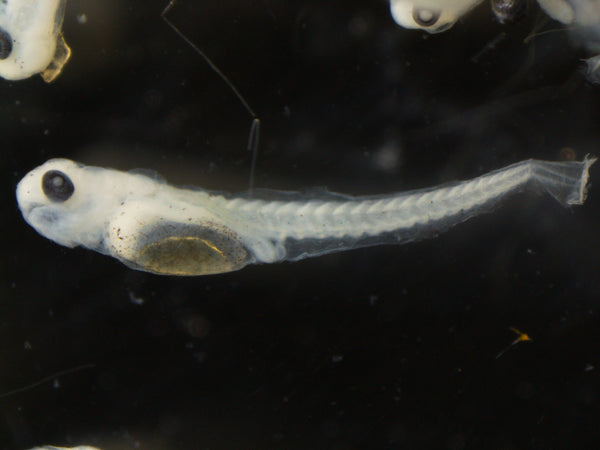- Continue Shopping
- Your Cart is Empty
Food from within: The botanical-style aquarium and "feeding optimization"
Pretty much every one of us has had a period of time when we couldn't feed our fishes. Maybe we were out of town. Maybe work got in the way...maybe we just got lazy!
It's not all that uncommon. And of course, it's been very widely known that fishes can go a while without eating. In fact, it's not only perfectly fine- it is, in many ways, a sort of replication of what happens in their natural environment, right? I mean, does every fish find all the food it wants every day?
Probably not.
Now, sure, fishes tend to migrate to where the food sources are. Now, we've talked extensively in several blog posts over the past couple of years about the idea of allochthonous input (literally, food from the sky, lol) and how it impacts the feeding habits of many fishes, as well as their social and behavioral habits, and what could loosely be referred to as their "migratory patterns."

It's long been known that fishes which inhabit the flooded forest floors (igapo) of Amazonia, for example, tend to literally "follow the food" and move into new areas where greater feeding opportunities exist, and will even adjust their dietary preferences seasonally to accommodate the available foods.
In this instance, it typically means areas of the forest where overhanging vegetation offers falling peices of fruit, seeds, nuts, plant parts, and the occasional clumsy insect, like an ant or small beetle, which falls from the branches of said vegetation.
So, here is where the idea gets interesting to me:

I think that our botanical-style aquariums are truly "optimized" for providing supplemental food resources for our fishes, especially when we "forget" to feed them directly. Decomposing leaves and botanicals form a "substrate" for fungal growth, microorganisms (like Paramecium, Euglena, etc.), small crustaceans (like Daphnia, Gammarus, etc.) and worms.
Algal films and bacterial biofilms are a food source for not only the aforementioned organisms, but many fishes. And of course, for fishes ranging from catfishes to barbs to livebearers, the botanicals and leaves themselves (and the detritus they produce as they decompose) form a "direct food" for fishes.

All of these food sources are important to fishes at all stages of heir lives. We've all seen this before in planted aquariums, where baby fishes will find plenty of supplemental foods.
Macrophytes- aquatic plants which grow in and around the water, emerged, submerged, floating, etc., contribute to the physical structure and spatial organization of the water bodies they inhabit, and they are primary contributors to the overall biological stability of the habitat, conditioning the physical parameters of the water.
Of course, anyone who keeps a planted aquarium could attest to that, right?
One of the interesting things about macrophytes is that, although there are a lot of fishes which feed directly upon them, the plants themselves are perhaps most valuable as a microhabitat for algae, zooplankton, and other organisms upon which fishes feed on. Small aquatic crustaceans seek out the shelter of plants for both the food resources they provide (i.e.; zooplankton, diatoms) and for protection from predators (yeah, the fishes!).
So, those "jungle style" tanks have a very functional aspect to them!
And leaf litter, botanical materials, etc. serve as perfect shelter for these macrophytes to grow and multiply as mentioned above. And where you find these life forms...you find fishes. Often, baby fishes.
So, in my opinion, it goes without saying that a botanical-style blackwater or brackish aquarium would be an optimized system for feeding fry of many fishes, right?
We talked about killifishes and keeping them in permanent, biotope-inspired tanks, and I think you can stretch it and suggest that many different fishes can be kept in botanical-influenced tanks for the specific purpose of offering supplemental foods for fry...and adults.

I'd like to see more aquariums set up in a botanical-dense style for the specific purpose of providing an "in-tank refugium" of sorts for feeding baby fishes. You could "inoculate" the botanical bed with cultures of microorganisms and crustaceans and let the tank run in a bit before adding fishes.

Those botanical beds we utilize as part of our "functional aquascaping" practice will lead the way in creating unique rearing systems for a variety of fishes.

I suppose one could actually breed the fishes (as in the case of killies, for example) in the setup, or you could transfer newly-hatched fry into the aquarium for rearing.

The possibilities for productive (or, reproductive, as the case may be!) experimentation are endless! And the potential breakthroughs for spawning, rearing, and grow-out for many fishes previously considered difficult or challenging are many!
We've talked about this concept of botanical-style aquariums as vehicles of "feeding optimization" before, and I believe it's time for us to do some more work in this area!
Who's in?
Stay bold. Stay creative. Stay diligent. Stay curious...
And Stay Wet.
Scott Fellman
Tannin Aquatics












Scott Fellman
Author